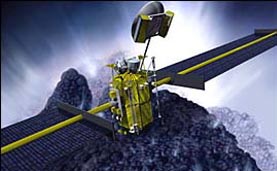This computer-generated drawing shows from left to right, Comet Tempel 1, the Deep Impact impactor and the flyby spacecraft.
Click on image for full size
Courtesy of NASA
Deep Impact Mission
NASA chose Deep Impact to be part of a special series called the Discovery Program on July 7, 1999. The Discovery program specializes in low-cost, scientific projects. In May 2001, Deep Impact was given the "go" from NASA to start with mission development. Deep Impact already has a preliminary launch date of January 6, 2004.
The Deep Impact mission is simple; blast a hole in Comet Tempel 1 that is the size of a football field and is 7 stories deep! Deep Impact will consist of large spacecraft and an impactor. The 770 pound impactor will be released from the flyby spacecraft. Moving at speeds up to 22,300 MPH, the copper impactor will collide with the comet on July 4, 2005. Scientists can then study the core of the comet, the surface of the comet and the material that is blasted off of the comet from impact.
Deep Impact is to complement two other comet missions. These two missions are called Stardust and Comet Nucleus Tour (CONTOUR). Stardust will gather comet dust and bring it back to Earth, while CONTOUR will fly by three different comets.
A similar project that would have landed a probe on Tempel 1 was scrapped by NASA because of a lack of funding.
You might also be interested in:

A mission that would have sent a probe to comet Tempel 1 has been postponed indefinitely. This mission, the first of it's kind, would have landed on the comet in 2005. Unfortunately, other projects have
...more
The Hubble Space Telescope (HST) was one of the most important exploration tools of the past two decades, and will continue to serve as a great resource well into the new millennium. The HST found numerous
...more
Driven by a recent surge in space research, the Apollo program hoped to add to the accomplishments of the Lunar Orbiter and Surveyor missions of the late 1960's. Apollo 11 was the name of the first mission
...more
Apollo 12 was launched on Nov. 14, 1969, surviving a lightning strike which temporarily shut down many systems, and arrived at the Moon three days later. Astronauts Charles Conrad and Alan Bean descended
...more
Apollo 15 marked the start of a new series of missions from the Apollo space program, each capable of exploring more lunar terrain than ever before. Launched on July 26, 1971, Apollo 15 reached the Moon
...more
NASA chose Deep Impact to be part of a special series called the Discovery Program on July 7, 1999. The Discovery program specializes in low-cost, scientific projects. In May 2001, Deep Impact was given
...more
The Galileo spacecraft was launched on October 19, 1989. Galileo had two parts: an orbiter and a descent probe that parachuted into Jupiter's atmosphere. Galileo's main mission was to explore Jupiter and
...more














